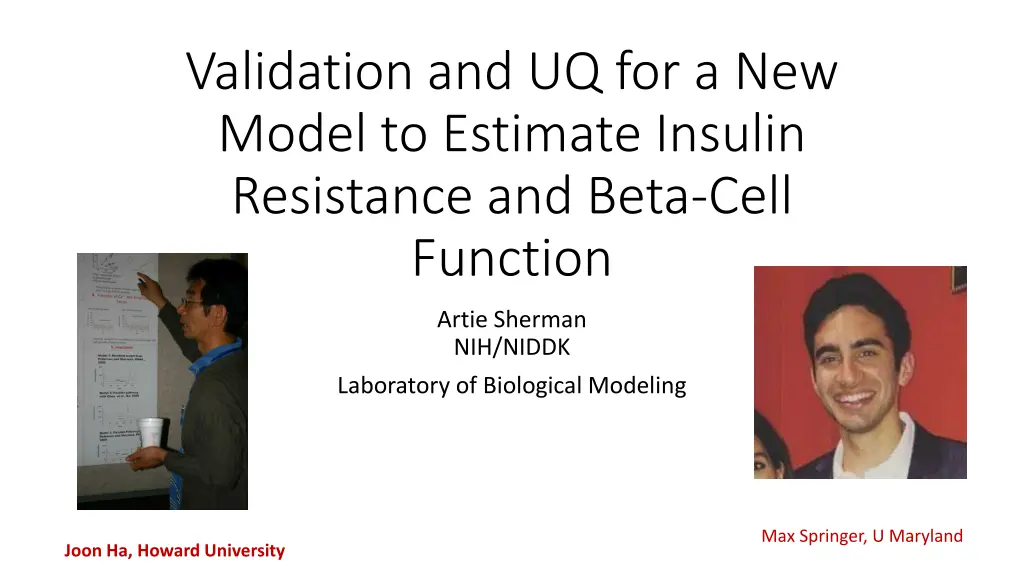
Model Validation and Parameter Estimation for Insulin Resistance
Explore a new model to estimate insulin resistance and beta-cell function through parameter estimation and adaptation of a longitudinal model. The study aims to simplify data collection, improve accuracy, and develop a more effective method than existing algebraic indices. Details include the Federal Women Study, mean fits to data, and error histograms revealing skewed but useful error distributions.
Uploaded on | 0 Views
Download Presentation

Please find below an Image/Link to download the presentation.
The content on the website is provided AS IS for your information and personal use only. It may not be sold, licensed, or shared on other websites without obtaining consent from the author. If you encounter any issues during the download, it is possible that the publisher has removed the file from their server.
You are allowed to download the files provided on this website for personal or commercial use, subject to the condition that they are used lawfully. All files are the property of their respective owners.
The content on the website is provided AS IS for your information and personal use only. It may not be sold, licensed, or shared on other websites without obtaining consent from the author.
E N D
Presentation Transcript
Validation and UQ for a New Model to Estimate Insulin Resistance and Beta-Cell Function Artie Sherman NIH/NIDDK Laboratory of Biological Modeling Max Springer, U Maryland Joon Ha, Howard University
Recap and Introduction Yesterday we discussed a longitudinal model for T2D progression based on: fast positive feedback, slow negative feedback bistability We saw that insulin resistant vs insulin deficient had different OGTT patterns But how can we decide which group a patient belongs to? We will explore whether the longitudinal model can be adapted to estimate insulin resistance and beta-cell function
Goals We seek something that: uses OGTT data (simpler, less invasive than clamp or FSIGT) easier to implement than Cobelli Oral Minimal Model more complex than existing algebraic indices (Matsuda, HOMA, etc.) but with better properties
Adaptation of Longitudinal for Parameter Estimation dG = + ( ) R E S I G 0 0 G I dt V dI = ; ( ) R G kI IS dt dt ( ) d G = For fitting, we fix the slow variables ( , ) Other features: ?0= ?0(?,??) ??? derived from a model for exocytosis (first and second phase secretion) There are many parameters, we fit just 2 ( G dt ) d = G ) dt [ ( ( )] d P A G = Ha et al, Endocrinology, 157(2):624-635; Am. J. Physiol. 319(2):E410-E426
Federal Women Study Stephanie Chung, NIDDK Anne Sumner, NIDDK Women who work for the federal government (reduces social variability) N = 113, 66 Black, 47 White BMI 32 5.6 (range 20 45) Age 42.8 9.7 (range 24 62) 76 NGT, 37 PreDM
Mean Fits to Data FWS Mean Glucose FWS Mean Insulin 150 100 Data Fit Data Fit 90 140 80 130 70 Glucose (mg/dl) 120 Insulin ( U/ml) 60 110 50 40 100 30 90 20 80 10 70 0 0 20 40 60 80 100 120 0 20 40 60 80 100 120 t (min) t (min)
Error Histograms Histogram of R2 FWS FWS WRSS r20 = 0.006 70 60 60 R2: 96% > 0.9 median(WRSS) = 79.7 iqr(WRSS)/2 = 50.1 96% > 0.9 50 50 40 40 30 30 20 20 10 10 0 0 0 100 200 300 400 500 600 700 0 0.1 0.2 0.3 0.4 0.5 0.6 0.7 0.8 0.9 1 Error distribution is skewed but good for most individuals
FWS mSI vs MINMOD SI: Correlation and Agreement No systematic deviation
Matsuda Index 10000 ?0?0 ? ?
FWS Matsuda vs MINMOD SI Matsuda correlation with MINMOD similar to mSI but agreement with MINMOD much poorer: systematic overestimation
Comparison of sigma with AIR 2.0 R^2 = 0.45, R = 0.67 Correlation good but scales very different 1.5 sigma 1.0 0.5 0.0 0 1000 2000 3000 4000 AIR
Subject #51 0.130 0.155 0.09 0.14 1 SD 1 SD
Zoomed 9% > 0.1 5% > 0.1
UPMC Silva Arslanian, MD Joon Young Kim, Ph. D. UPMC Children's Hospital of Pittsburgh Syracuse University, NY
Study Details Study Details Study population (n=130) Age 10 20 BMI 85%ile 60 boys & 70 girls; 57 African-American & 73 American-White 68 with NGT, 33 with IGT, 29 with T2D 2-hr OGTT hyperinsulinemic-euglycemic clamp to measureinsulin sensitivity Hyperglycemic clamp for 1st- and 2nd-phase insulin secretion
Mean Data Fits Mean G Silva Mean Insulin Silva 170 250 Data Fit Data Fit 160 200 150 140 150 I ($ $U/ml) G (mg/dl) 130 120 100 110 100 50 90 0 80 0 20 40 60 80 100 120 0 20 40 60 80 100 120 t (min) t (min)
Error Histograms Histogram R2 Silva Histogram WRSS Silva 80 90 80 70 70 79% > 0.9 60 mean(sd): 218(268) 60 50 median(IQR/2): 122(105) 50 40 40 30 30 20 20 10 10 0 0 0 200 400 600 800 1000 1200 1400 1600 0.5 0.55 0.6 0.65 0.7 0.75 0.8 0.85 0.9 0.95 1 Error somewhat bigger than with FWS
UPMC SI vs Clamp SI: Correlation and Agreement mSI systematically smaller than cSI, scatter and error increase with cSI Correlation OK
UPMC Matsuda vs cSI: Correlation and Agreement Matsuda also systematically underestimates cSI Performance of mSI, Matsuda are similar (they agree well not shown) Could be an issue of OGTT-based measures? Cobelli?
Other Comparisons From the literature
OMM vs Clamp, mSI vs Clamp Dalla Man et al, AJP-Endo 289:954 2005 Correlation lower, also systematically lower than clamp Correlation good but systematically lower than clamp OGTT or MMT?
Cobelli phid vs clamp MMT; sigma vs clamp Steil, Diabetes 2004 53(5):1201-7 No Correlation Also no correlation with AIR: R = 0.28, p = 0.27
Cobelli phis vs clamp MMT; sigma vs clamp Steil, Diabetes 2004 53(5):1201-7
Conclusions Simpler to implement than clamp, FSIGT, needs less data Not much more complex than algebraic measures (HOMA, Matsuda, IGI) Agrees well with MINMOD SI and AIR better than Matsuda Agreement with clamp not as good but perhaps acceptable similar to Matsuda Correlation with 1st phase clamp BCF much better than OMM Correlation with 2nd phase clamp BCF similar to OMM Precision good (mostly < 5%) Correlation poor, but may not matter because bounds are tight
The model defines a new Disposition Index mDI = ???
B D C A H F E G oDI decreases vs. NGT cDI decreases vs. NGT mDI-woI decreases vs. NGT mDI decreases vs. NGT
ROC Analysis: Detecting IGT, T2D Cross-Sectionally IGT T2D mDI is better than oDI, cDI at detecting IGT, equally good at detecting T2D reason: mDI drops more sharply between NGT and IGT
ROC Analysis for T2D Prediction Sangsoo Kim, MD, PNUH Korean Genome and Epidemiology Study N = 6639 OGTTs (0, 60, 120 min) Every 2 years for 14 years Event: Converted to T2D any time between years 4 and 14




